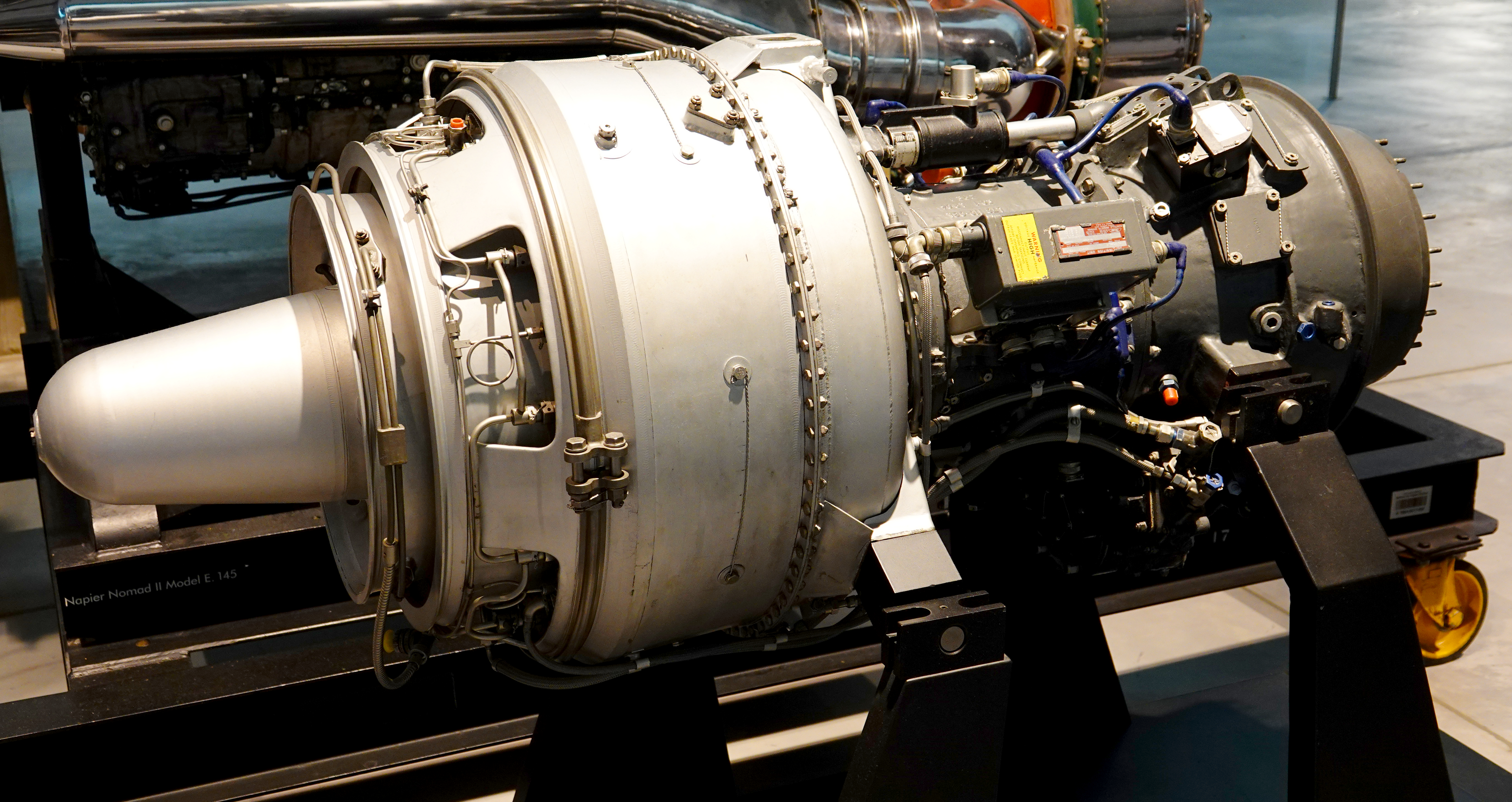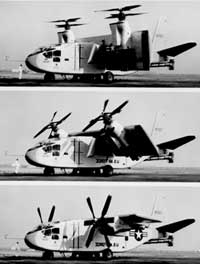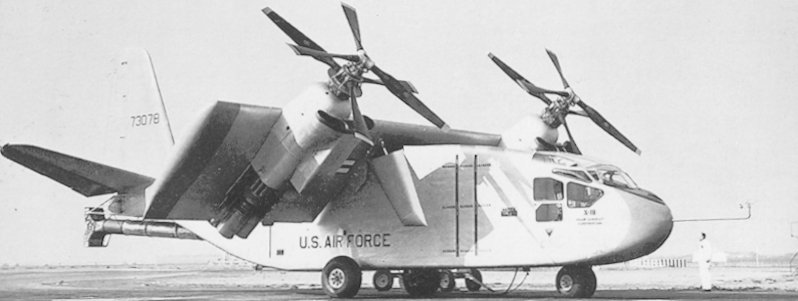|
Vertol VZ-2
The Vertol VZ-2 (or Model 76) was a research aircraft built in the United States in 1957 to investigate the tiltwing approach to vertical take-off and landing. Design and development The aircraft had a fuselage of tubular framework (originally uncovered) and accommodation for its pilot in a helicopter-like bubble canopy. The T-tail incorporated small ducted fans to act as thrusters for greater control at low speeds. Ground tests began in April 1957 and on 13 August, the VZ-2 took off for the first time in hover mode only. On 23 July 1958, the aircraft made its first full transition from vertical flight to horizontal flight. By the time the test program ended in 1965, the VZ-2 had made some 450 flights, including 34 full transitions. The aircraft has been preserved by the National Air and Space Museum in storage at the Paul E. Garber Preservation, Restoration, and Storage Facility The Paul E. Garber Preservation, Restoration, and Storage Facility, also known colloquially as " ... [...More Info...] [...Related Items...] OR: [Wikipedia] [Google] [Baidu] |
WikiProject Aircraft
A WikiProject, or Wikiproject, is a Wikimedia movement affinity group for contributors with shared goals. WikiProjects are prevalent within the largest wiki, Wikipedia, and exist to varying degrees within Wikimedia project, sister projects such as Wiktionary, Wikiquote, Wikidata, and Wikisource. They also exist in different languages, and translation of articles is a form of their collaboration. During the COVID-19 pandemic, CBS News noted the role of Wikipedia's WikiProject Medicine in maintaining the accuracy of articles related to the disease. Another WikiProject that has drawn attention is WikiProject Women Scientists, which was profiled by ''Smithsonian Magazine, Smithsonian'' for its efforts to improve coverage of women scientists which the profile noted had "helped increase the number of female scientists on Wikipedia from around 1,600 to over 5,000". On Wikipedia Some Wikipedia WikiProjects are substantial enough to engage in cooperative activities with outside organization ... [...More Info...] [...Related Items...] OR: [Wikipedia] [Google] [Baidu] |
Lycoming T53
The Lycoming T53, (company designation LTC-1) is a turboshaft engine used on helicopters and (as a turboprop) fixed-wing aircraft since the 1950s. It was designed at the Lycoming Turbine Engine Division in Stratford, Connecticut, by a team headed by Anselm Franz, who was the chief designer of the Junkers Jumo 004 during World War II. A much larger engine, similar in overall design, became the Lycoming T55 produced by Honeywell Aerospace. The T53 model is produced by Ozark Aeroworks LLC. Variants Military designations ;T53-L-1 : ;T53-L-1A : 770 hp (645 kW) ;T53-L-1B : 860 hp (645 kW) ;T53-L-3 : ;T53-L-5 : 960 hp (720 kW) ;T53-L-7 : ;T53-L-11 : 1100 hp (820 kW) ;T53-L-13 : ;T53-L-13B : 1400 shp (1044 kW) improved L-11 ;T53-L-701 : 1,400 hp (1044 kW) Turboprop variant used on Mohawk and AIDC T-CH-1 ;T53-L-703 : 1,800 hp (1343 kW) improved durability variant of the L-13B Civil designations ;T5307A :commercial L-7 ;T5309A :commercial L-9A ;T5309B :commercial L-9B ;T5309C :s ... [...More Info...] [...Related Items...] OR: [Wikipedia] [Google] [Baidu] |
NASA Aircraft
The National Aeronautics and Space Administration (NASA ) is an independent agency of the US federal government responsible for the civil space program, aeronautics research, and space research. NASA was established in 1958, succeeding the National Advisory Committee for Aeronautics (NACA), to give the U.S. space development effort a distinctly civilian orientation, emphasizing peaceful applications in space science. NASA has since led most American space exploration, including Project Mercury, Project Gemini, the 1968-1972 Apollo Moon landing missions, the Skylab space station, and the Space Shuttle. NASA supports the International Space Station and oversees the development of the Orion spacecraft and the Space Launch System for the crewed lunar Artemis program, Commercial Crew spacecraft, and the planned Lunar Gateway space station. The agency is also responsible for the Launch Services Program, which provides oversight of launch operations and countdown management ... [...More Info...] [...Related Items...] OR: [Wikipedia] [Google] [Baidu] |
Boeing Aircraft
The Boeing Company () is an American multinational corporation that designs, manufactures, and sells airplanes, rotorcraft, rockets, satellites, telecommunications equipment, and missiles worldwide. The company also provides leasing and product support services. Boeing is among the largest global aerospace manufacturers; it is the third-largest defense contractor in the world based on 2020 revenue, and is the largest exporter in the United States by dollar value. Boeing stock is included in the Dow Jones Industrial Average. Boeing is incorporated in Delaware. Boeing was founded by William Boeing in Seattle, Washington, on July 15, 1916. The present corporation is the result of the merger of Boeing with McDonnell Douglas on August 1, 1997. Then chairman and CEO of Boeing, Philip M. Condit, assumed those roles in the combined company, while Harry Stonecipher, former CEO of McDonnell Douglas, became president and COO. The Boeing Company's corporate headquarters is in Chicago, Il ... [...More Info...] [...Related Items...] OR: [Wikipedia] [Google] [Baidu] |
Tiltwing Aircraft
A tiltwing aircraft features a wing that is horizontal for conventional forward flight and rotates up for vertical takeoff and landing. It is similar to the tiltrotor design where only the propeller and engine rotate. Tiltwing aircraft are typically fully capable of VTOL operations.Markman, Steve and Bill Holder. "Tilt-Wing VTOL Systems". ''Straight Up: A History of Vertical Flight''. Schiffer Publishing, 2000. . The tiltwing design offers certain advantages in vertical flight relative to a tiltrotor. Because the slipstream from the rotor strikes the wing on its smallest dimension, the tiltwing is able to apply more of its engine power to lifting the aircraft. For comparison, the V-22 Osprey tiltrotor loses about 10% of its thrust to interference from the wings. Another advantage of tiltwing aircraft is the ease of transition between VTOL and horizontal flight modes. A tiltrotor must first fly forwards like a helicopter, building airspeed until wing lift is sufficient to all ... [...More Info...] [...Related Items...] OR: [Wikipedia] [Google] [Baidu] |
1950s United States Experimental Aircraft
Year 195 ( CXCV) was a common year starting on Wednesday (link will display the full calendar) of the Julian calendar. At the time, it was known as the Year of the Consulship of Scrapula and Clemens (or, less frequently, year 948 '' Ab urbe condita''). The denomination 195 for this year has been used since the early medieval period, when the Anno Domini calendar era became the prevalent method in Europe for naming years. Events By place Roman Empire * Emperor Septimius Severus has the Roman Senate deify the previous emperor Commodus, in an attempt to gain favor with the family of Marcus Aurelius. * King Vologases V and other eastern princes support the claims of Pescennius Niger. The Roman province of Mesopotamia rises in revolt with Parthian support. Severus marches to Mesopotamia to battle the Parthians. * The Roman province of Syria is divided and the role of Antioch is diminished. The Romans annexed the Syrian cities of Edessa and Nisibis. Severus re-establish his ... [...More Info...] [...Related Items...] OR: [Wikipedia] [Google] [Baidu] |
LTV XC-142
The Ling-Temco-Vought (LTV) XC-142 was a tri-service tiltwing experimental aircraft designed to investigate the operational suitability of vertical/short takeoff and landing (V/STOL) transports. An XC-142A first flew conventionally on 29 September 1964, and on 11 January 1965, it completed its first transitional flight by taking off vertically, changing to forward flight and finally landing vertically. Its service sponsors pulled out of the program one by one, and it eventually ended due to a lack of interest after demonstrating its capabilities successfully. Development In 1959 the United States Army, Navy and Air Force began work on the development of a prototype V/STOL aircraft that could augment helicopters in transport-type missions. Specifically they were interested in designs with longer range and higher speeds than existing helicopters, in order to support operations over longer distances, or in the case of the United States Marine Corps, from further offshore. On 27 Jan ... [...More Info...] [...Related Items...] OR: [Wikipedia] [Google] [Baidu] |
Kaman K-16B
The Kaman K-16B was an experimental vertical-takeoff-and-landing aircraft that was constructed by Kaman Aircraft for the United States Navy in 1959 to evaluate the tiltwing concept. Converted from a Grumman Goose amphibian, the K-16B underwent extensive wind tunnel and tethered testing, but was not flown before the project was terminated in 1962. Design and development During the late 1950s, there was extensive interest in the vertical takeoff and landing concept for aircraft, with multiple experimental types ordered to develop the technology for potential service. The United States Navy contracted with Kaman Aircraft of Bloomfield, Connecticut to build a testbed based on the company's 'rotorprop' concept for tiltwing aircraft,Swanborough 1964, p.50. using a Grumman JRF-5 Goose amphibian and other existing parts to reduce the cost and time necessary.''Jane's'' 1959–1960, p.331. The fuselage and tail of the Goose were mated to a new tilting wing and engine configuration; the ... [...More Info...] [...Related Items...] OR: [Wikipedia] [Google] [Baidu] |
Hiller X-18
The Hiller X-18 was an experimental cargo transport aircraft designed to be the first testbed for tiltwing and V/STOL (vertical/short takeoff and landing) technology. Development Design work started in 1955 by Stanley Hiller Jr and Hiller Aircraft Corporation received a manufacturing contract and funding from the U.S. Air Force to build the only X-18 built, serialled ''57-3078''. To speed up construction and conserve money, the plane was constructed from scavenged parts including a Chase YC-122C Avitruc fuselage, ''49-2883'', and turboprops from the Lockheed XFV-1 and Convair XFY-1 Pogo experimental fighter programs. The tri-bladed contra-rotating propellers were a giant 16 ft (4.8 m) across. The Westinghouse turbojet engine had its exhaust diverted upwards and downwards at the tail to give the plane pitch control at low speeds. Hiller nicknamed their X-18 the Propelloplane for public relations purposes. Service history Preliminary testing occurred at Moffett F ... [...More Info...] [...Related Items...] OR: [Wikipedia] [Google] [Baidu] |
Dornier Do 29
The Dornier Do 29 was an experimental aircraft developed by Dornier Flugzeugwerke and the ''Deutsche Versuchsanstalt für Luftfahrt'' (German Aviation Laboratory) in the 1950s, used to test a tilting-propeller system for short takeoff and landing ( STOL) aircraft. The concept was proved to be successful in flight testing; however, no further development of the system or aircraft was proceeded with, and at the conclusion of its test program the Do 29 was retired. Design and development During the Second World War, Heinrich Focke of Focke-Achgelis, a manufacturer of helicopters, developed a design for a short-takeoff-and-landing aircraft that would utilise a system of pusher propellers, one on each wing in a pusher configuration, to provide downward thrust and enhance lift.Goebel, Greg"Dornier Civil Aircraft". ''VectorSite'', April 2010. Accessed 2010-06-10. Designated Fa 269, the design was not developed due to the state of the war. In the 1950s, however, a renewed interest in ... [...More Info...] [...Related Items...] OR: [Wikipedia] [Google] [Baidu] |




.jpg)

